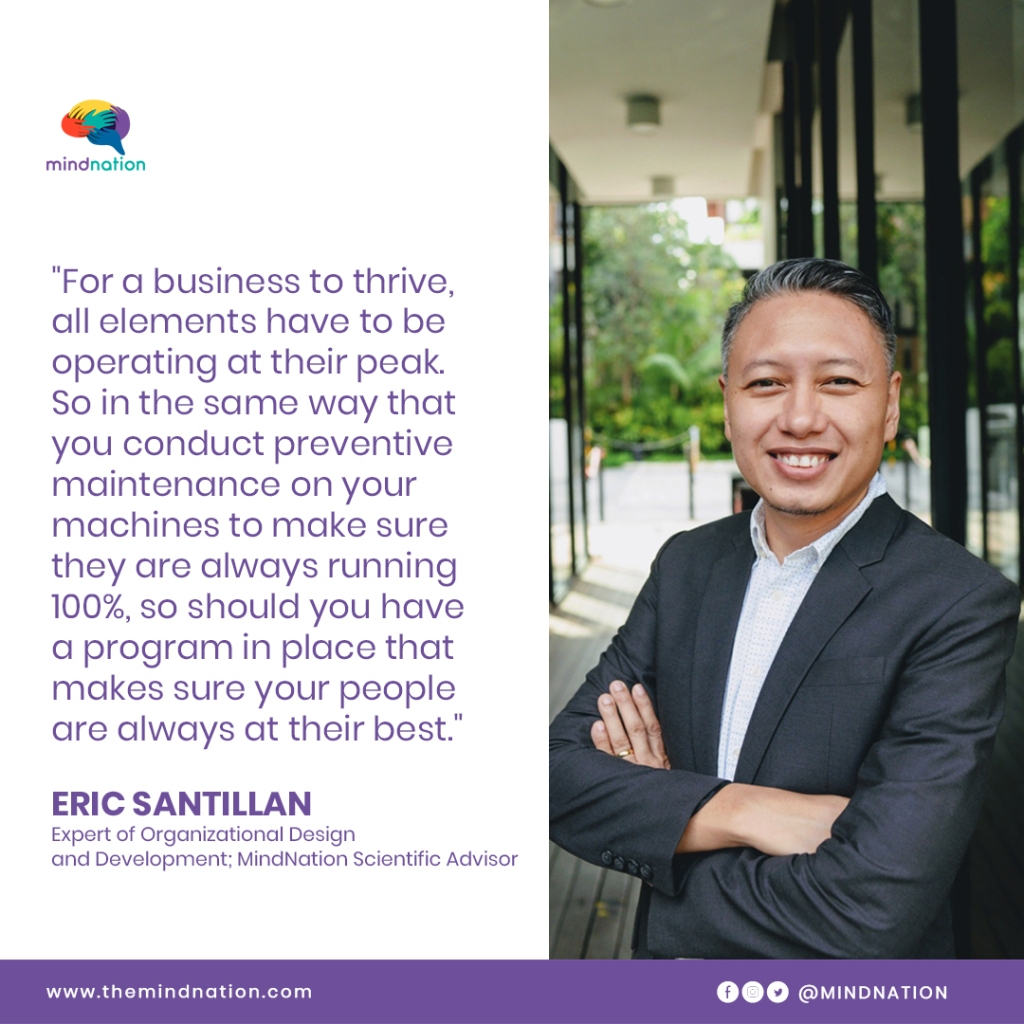Eric Santillan’s road to psychology, counseling, and organizational development started — of all places — when he was studying to be a Jesuit priest in the early 2000s. “Jesuit formation is very psycho-spiritual,” he explains. So apart from studying theology, he also trained as a career and marriage counselor, moderated student organizations in the university, and even designed curriculums for schools. In 2006, he left theology school to become a full-time psychologist and counselor.
Today, Eric is a member of the MindNation Scientific Board, a relationship counselor, and a productivity and Organizational Development consultant. “As an OD consultant, organizations come to me when they have issues and problems and need clarity,” he explains. “And then I use organizational and management tools to help their people thrive and reach their full potential.”
Stress during the COVID-19 pandemic
One of things Eric realized in his 22-year career as an OD consultant was that big problems stem from minor irritations. “Little stresses build up over time and if they are not addressed, they blow up,” he shares.

An example would be the issue of workplace stress. A MindNation Pulse Survey of more than 6,000 full-time employees in the Philippines taken from September 2020 to April 2021 revealed that 61% of respondents are feeling stressed during the COVID-19 pandemic. Eric clarifies, however, that the pandemic did not cause this spike in stress; rather, it simply magnified stressful situations that would — pre-pandemic — have otherwise been just considered to be inconveniences. “People already had mental health challenges before the pandemic; the pandemic just highlighted them and made them very real,” he explains. Some examples of these stressful situations:
- Bad management practices. Employees were already dealing with long working hours, heavy workload, job insecurity, and conflicts with co-workers or bosses long before the pandemic, but they have become more overwhelming now due to pandemic-related stressors like work-life imbalance, isolation, managing fears about the COVID-19 virus, and financial insecurity.
- Limited physical and psychological space. Prior to the pandemic, parents could take a breather from child-care duties and other household responsibilities by sending their kids to school or just leaving the house for some “me-time” at a nearby coffee shop. But school closures and social distancing policies now meant that people are stuck at home 24/7 with little to no reprieve.
- Missing support systems. “Deaths in the family and becoming a new parent are stressful transitions, and the pandemic has erased whatever support we would normally get during these major life changes,” Eric points out. Mourning rituals have been shortened, grandparents can no longer visit to help babysit — the people most affected by these transitions have no choice but to struggle on their own.
How stress affects work
If left unaddressed, stress can contribute to decreased organizational performance, decreased employee overall performance, high error rate and poor quality of work, high staff turnover, and absenteeism due to physical and mental health problems.
As a manager, it is therefore important to take steps to ensure that employees are not subjected to unnecessary stress. “For a business to thrive, all elements have to be operating at their peak. So in the same way that you conduct preventive maintenance on your machines to make sure they are always running 100%, so should you have a program in place that makes sure your people are always at their best,” Eric says.
How to reduce workplace stress
While managers and leaders cannot address all the stresses that a team member is struggling with in their personal lives, there some things that they can do to make the workplace less stressful:
- Ask yourself: ‘Am I the source of stress?’ It’s possible you are inadvertently causing your employees stress, so be open to feedback about your leadership style. Another way to find out is to check the turnover rate in your department. “In teaching, there is a concept called ‘student factor’ or ‘teacher factor,’” Eric relates. “When one or two students fail in a class,that’s probably a student factor; but if 10 or 15 people flunk, then that’s a red flag, it’s a sign that there is probably an issue with the teacher. So it’s the same with workplace turnover– is it an employee factor or a manager factor? In some companies I have worked with, managers get sent for retraining if a certain number of people resign over a certain amount of time.”
- Get to know your team. Take into account the personal lives of employees and recognise that the demands of home will sometimes clash with the demands of work. “Letting your team know that they are not just workers, but that they’re recognized as individuals, goes a long way,” Eric says.
- Praise in public, correct in private. This simply means that when you have something positive to say about a team member, make sure others are aware of the praise; but if you are issuing a correction or reprimand, handle it one-on-one. Praising in public pumps up the self-esteem of the team member, while handing out negative feedback privately ensures that the employee is not publicly shamed in front of his or her peers. The latter creates stress and resentment, and damages morale.
- Mess creates stress. Disorganization contributes to stress, so always be clear when relaying instructions, Make sure that everyone is properly trained for their job, and encourage an environment where employees can openly raise concerns about their duties and workload.
- Try to celebrate small wins. Don’t wait for a project to end so you can celebrate; instead, break up the projects into milestones, and give positive feedback when people do a good job. “A company I know gives a small fund to each department, so that team members can treat themselves whenever they feel there is a cause for celebration,” Eric shares.
- Practice what you preach. “Don’t say anything that you will not do yourself,” Eric cautions. So model work-life balance and stress management techniques so that employees down the line will follow suit.
- Partner with a mental health and well-being company that addresses mental health challenges holistically. This means working with an Employee Assistance Program provider that addresses all dimensions of an employee’s well-being — physical, mental, emotional, spiritual, and cultural — because you cannot have one without the other.
And if you do already have an Employee Assistance Program in place, don’t rely on it to be the cure-all for all your team’s well-being concerns. “Addressing workplace stress is not just the work of the EAP partner,” Eric shares. “It should be part of the organization’s culture.” This means normalizing the conversation about mental health in everyday interactions, granting paid mental health leaves, or even giving special mental health assistance to employees being groomed for leadership roles so they do not feel overwhelmed or stressed. “This way, the mental health program becomes holistic and robust, not just something offered on the side,” he adds.
“Workplace stress is a management issue,”
Eric Santillan
“Workplace stress is a management issue,” Eric concludes. A great manager is aware of their team member’s stress levels and takes proactive steps to reduce stress in the workplace. By reducing workplace stress, you not only improve the lives of your team members, you create an environment where they enjoy coming to work each day and become more productive.
MindNation is a mental health and well-being company that uses a data-based approach to create proactive, customized, holistic health programs for your employees. Partner with us to build happier, healthier, and more productive teams. Visit www.mindnation.com now!

